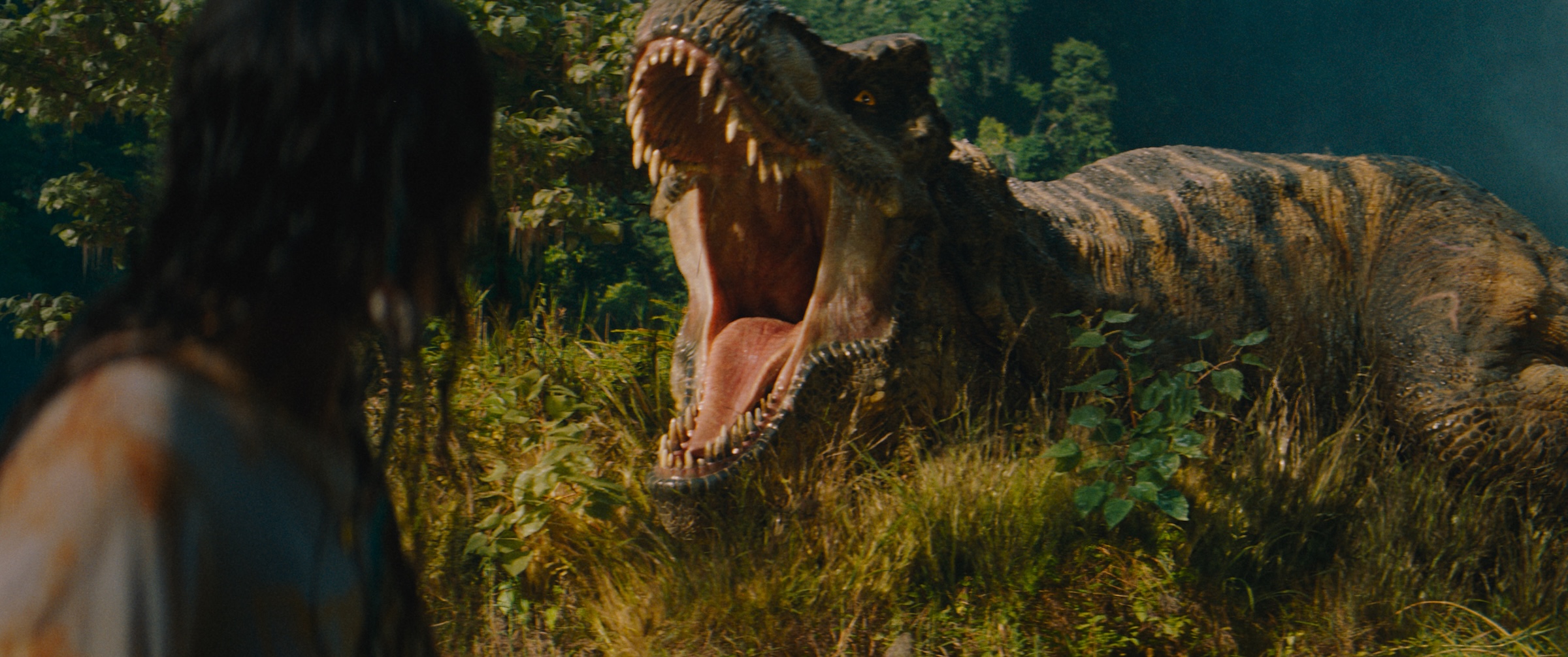The last three entries in the Jurassic Park movie franchise—Jurassic World (2015) and Jurassic World Dominion (2022), both directed by Colin Trevorrow, and Jurassic World: Fallen Kingdom (2018), from J.A. Bayona—may have been big money-earners at the box office, but they all lacked one essential ingredient: affection, or at least respect, for the very creatures who made them possible in the first place. All three movies are packed with dinosaurs—dinosaurs running, dinosaurs being sad and winsome, dinosaurs showing ruthless disregard for human life. And still, these poor behemoths came off as little more than an afterthought, thunderous, costly background noise for the movies’ boring human stars. Somehow, Chris Pratt playing an ace dinosaur whisperer was supposed to be more interesting than the magnificent, mysterious creatures to whom he was whispering—they were left to stumble around in a fog of stiff dialogue and stupid plot twists. What choice did they have? They’d been out of work for years, since 2001’s Jurassic Park III. Unlike munchworthy foliage, good roles for dinosaurs don’t just grow on trees.
[time-brightcove not-tgx=”true”]
But once again these forlorn losers of the extinction lottery have a Hollywood vehicle worthy of them: Jurassic World Rebirth, directed by Gareth Edwards and written by David Koepp (adapted, of course, from ideas originally generated by novelist Michael Crichton), features likable humans as well as some pleasantly cartoonish distasteful ones, and lots of dinosaurs just doing their thing. The movie takes place in a future, or a present, where humans have lost interest in dinosaurs and the theme parks they used to inhabit. Dinosaurs are now just nuisances, doing things like wandering into city traffic at inconvenient times. Most of the remaining beasties now live on remote islands near the equator, and most humans would conveniently like to forget them.
But not Rupert Friend’s big-pharma schemer Martin Krebs, on a mission to extract dino DNA which will be used in a revolutionary life-saving drug. The DNA can’t come from the small, cute, harmless dinosaurs; it must be extracted from the big, drooly ones with the massive choppers, while they’re still alive. Krebs hires covert ops specialist Zora Bennett (Scarlett Johansson) to help with that dirty work, offering her a salary with so many zeroes tacked onto it that she can hardly refuse. Plus, she’s still reeling from the recent traumatic loss of a colleague. What better way to recover from heartbreak than to get back to work? As Johansson plays her, Zora is pleasingly smart and ruthless, eager to get the best deal for herself. She’s also fearless about facing down seemingly insurmountable circumstances, which is why she makes the big bucks.
And she knows the right people: she enlists old friend and cohort Duncan Kincaid (Mahershala Ali), who owns a boat that can get the group to the island where the three hulking dino breeds, bearing the DNA necessary for Krebs’ miracle drug, live in relative peace. Krebs and Zora have also secured the services of Dr. Henry Loomis (Jonathan Bailey), a dreamy paleontologist who loves dinosaurs so much it hurts—at one point, he has the chance to touch the crinkly leg of a live brontosaurus, and it brings tears to his bespectacled eyes. You may be tempted to laugh, but Bailey plays it straight, and is somehow adorable.
The adventures of these mercenaries-on-a-mission will dovetail with those of a small family, who were sailing around in the ocean for kicks when an unpleasant prehistoric sea beast overturned their boat. (Dad Reuben is played by Manuel Garcia-Rulfo; Audrina Miranda plays his younger, dino-fearing daughter—she’s cute without wearing out her welcome.) Edwards (director of 2016’s Rogue One: A Star Wars Story and the 2014 Godzilla) and Koepp (who wrote the scripts for the first two Jurassic Park movies) know what they’re doing here: they locate the perfect ratio of human business to dinosaur antics, favoring the dinosaurs when in doubt.
And the dinos are great: there are swimming ones, slicing through the water with their gorgeous, seashell-speckled spines, only to emerge from the surface as scary-looking hulks with angry faces; flying ones, swooping from the sky to capture prey in their merciless talons; a harmless, adorable baby dino with a penchant for licorice (E.T. lives on); and one very upset mutant giant who peers from his melon-shaped head through a set of way-too-small eyes—he’s a Barney gone wrong, with nothing to do with his anger but stomp around his island prison on a rampage. But Jurassic World Rebirth isn’t all terror and mayhem. Moments of glorious beauty abound: the family of brontos that so enchant Dr. Loomis are particularly regal, their tails swirling around them like ribbons as they graze in a sunlit field.
There is some moderate child endangerment in Jurassic World Rebirth, and though I and perhaps you could do with less of that, it wouldn’t be a Jurassic Park movie without it. And the warnings of humankind’s imminent demise are perhaps more pronounced here than they were in the previous installments. At one point Dr. Loomis, the wisest of all these characters, pronounces solemnly, “When the Earth gets tired of us, she will shake us off like a summer wind.” That’s movie language for sure—real humans don’t talk like that. But then, movie language is part of what we go to the movies for, and sometimes it presents the unruly truth of things we’d rather not think about. Meanwhile, we do have some time—time to stem at least some of the damage we’ve done as a species, and time to indulge in the fantasy of prehistoric creatures big and small, carnivore and veg, deadly and friendly, resurrected from the sleep of extinction. That, too, is something the movies can give us, at least until they themselves go the way of the dinosaur.

